The job of cowboy has retained many of the traditions that started with the vaquero (cowboy) of Mexico. The early cowboys worked on ranches and periodically showed their skills at “roundups,” precursors to today’s rodeos. Stories of their doings have become legendary, but they often obscured the realities of the work they undertook: riding in wild terrain, with cattle, in all weather conditions. Cowboys spent most of their working time on horseback, so protective clothing became something of real importance–hence, the development of their distinctive chaps.
Chaps, sometimes pronounced “shaps,” refers to the garment worn by cowboys for the protection of their legs. The word chaps comes from the Spanish word chaparro, which refers to a low-growing thicket that damaged clothing as cowboys rode through it. Most chaps (other than woolies) are made from cowhide that is tanned and dyed and mostly “split,” making the leather supple and allowing for easier movement. The leather on the chaps had a slightly sticky effect on saddle leather and was better than ordinary trousers at helping to keep riders in their seat. Chaps are comprised of leggings and a belt. The leggings are buckled on (using the belt) over suitable trousers (denim jeans, for example), but have neither a seat nor a crotch. They are usually fitted around the hips, resting below the belt loops of the trousers.
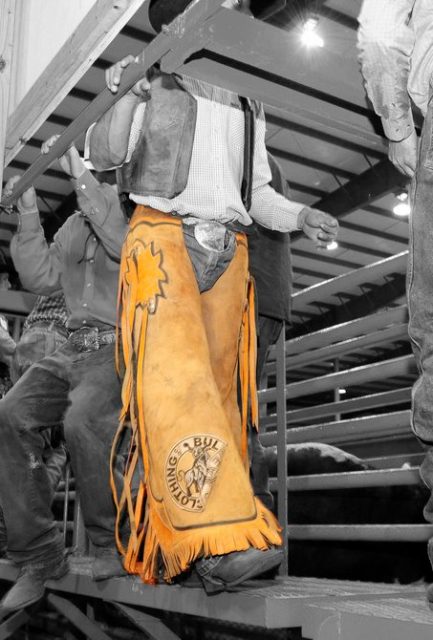
Chaps protect from the rope burns that cowboys could sustain when catching, holding down, and working with cattle, horses, or other livestock. Chaps also form a protective shield over the legs to help prevent cuts and grazes when riding through vegetation such as low scrub, bushes, thickets, or cacti, which often have vicious thorns. Originally, the mounted cattle herders of Spain and Mexico used a shield of leather in the form of pieces of cowhide attached to the rider’s saddle-horn; it was spread over the rider’s legs and also the horse’s chest.
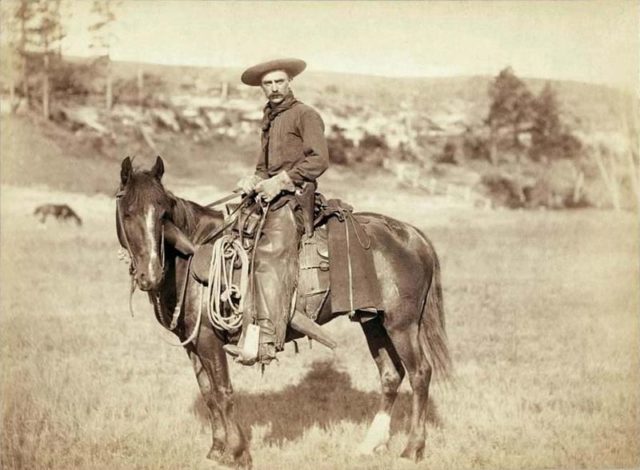
This apron-like protection was called an armas, which means shields. Later, only the rider was protected (no longer the horse), and further adjustments were made taking into account the local climate, the terrain, and various dangers. Many styles developed, often influenced by Native Americans and mountain men, while some adjustments were made for purely decorative purposes.
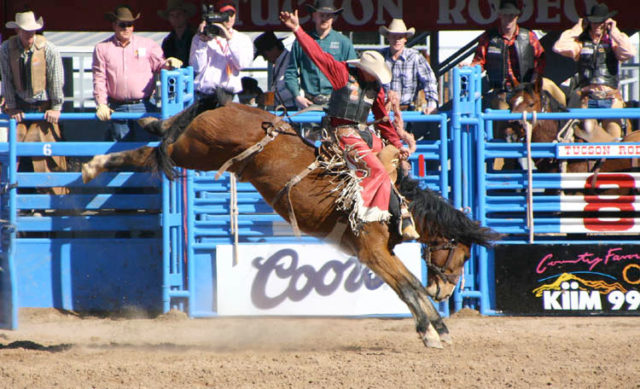
By 1870, the chaps design popularly used by Texas cowboys was the Shotgun. They were often called “stovepipes,” because of the straight and narrow leggings. Each side was cut from one piece of leather and was wrapped completely around the leg; it had a full-length zipper down the outside edge. Fringes edged the leggings, which were usually cut to fit over the boot. Because they fit so snugly, these chaps were better at trapping body heat, making the wearer warmer in windy and snowy or cold conditions. The chaps were not, however, very comfortable in hot or humid weather. This is the design most commonly seen at horse-show competitions for Western riders.
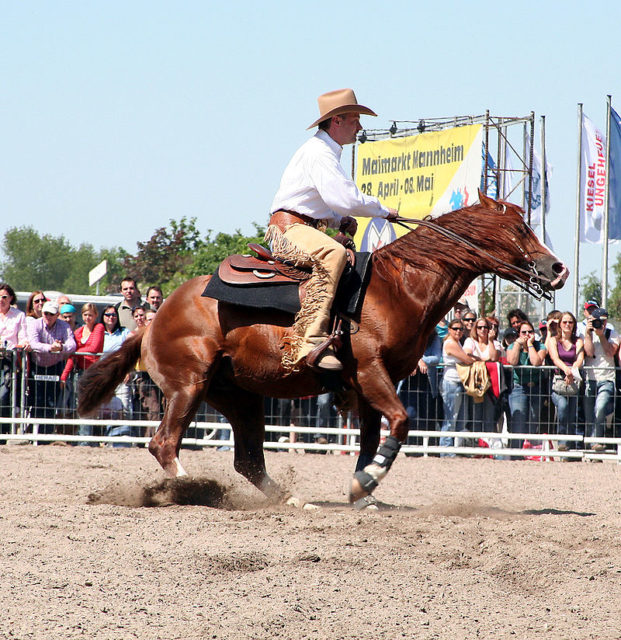
Woolies are very similar to the stovepipe-type chaps, but instead of the usual leather hides, these are made with fleece, hair-on cowhide, or even angora. Lined on the inside, they are warm and are mainly used by cowboys working in the colder northern Plains and Rocky Mountain areas.
Bat-wing chaps, which are made of smooth leather and cut wide with a flare at the bottom, are fastened around the thigh. The freedom of movement this affords to the lower leg makes it easier to mount a horse and is helpful when riding. This wider cut also allows air circulation, which means it is much cooler in hot weather. Bat-wing chaps are seen on working ranches, particularly in Texas, and are also used by rodeo contestants. The chaps used by the rodeo riders, though, tend to be far more colorful and decorated – most sport long and flowing fringes, unlike chaps for ranch-working cowboys.
Half-length chaps that stop just below the knee, with a long fringe along the bottom and at the sides, are known as Chinks. The leg shape is cut somewhere between that of the bat-wing and shotgun styles, with each leg fastened high on the thigh. They are cooler to wear and therefore more suitable for very warm climates; they’re mostly worn by cowboys from the Southwestern and Pacific states.
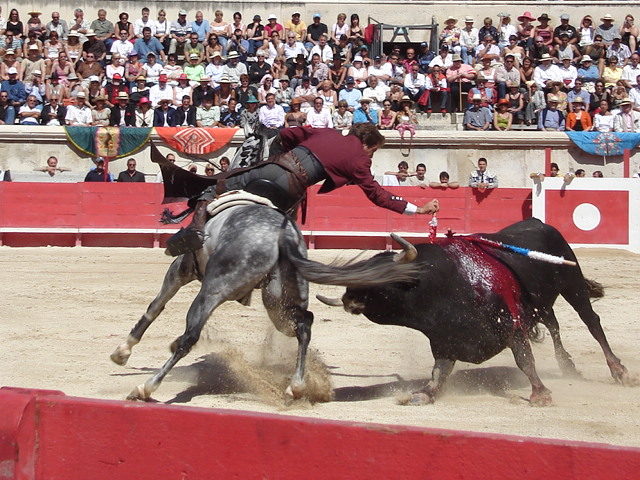
Zamorros is the style of chaps favored by Colombian riders. Their leggings closely hug the thigh and flare out below the knee, but differ from bat-wings in that they extend below the boot and have the distinctive triangular flare.
An early style of chaps from colonial Mexico became associated with the buckaroos (a corruption of Vaqueros) and are called Armitas. They have short leggings with completely closed legs and are put on like pants.
Since the main reason for wearing chaps is protection, it follows that persons other than riders would make use of them. For horseshoeing, the farrier’s apron copies the chinks styling, but without any fringing. It protects the farrier’s upper legs from scratches and cuts while shoeing or working on horses’ hooves. Ranch hands often use them when stacking hay to protect their clothing.
The shotgun style chaps used by motorbike riders are made of leather, with the smooth side out; they protect the rider from the wind and cold and also give partial protection from injury should the rider come off the bike.
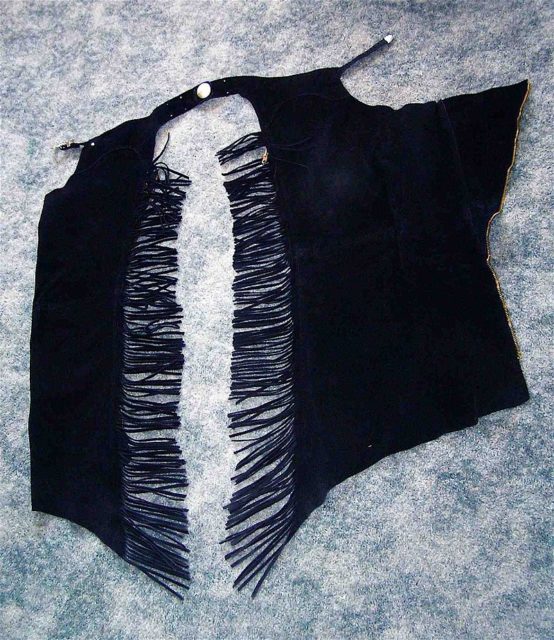
Chainsaw chaps are used as part of the safety equipment to protect the users’ legs from injury and are usually made of strong materials such as Kevlar. Hunters and other outdoor sportsmen use a similar garment as protection from rattlesnake bites, and birdwatchers and hikers use “upland chaps” made from nylon or waxed cotton, which protect legs from briars and thorns.
Chaps are popular in certain groups as fashion statements. Often tightly fitting and decorated to personal preference, they are worn without any garments beneath them, other than a codpiece. These are worn for decoration, though, and not for protective reasons.

Today, modern equipment such as the pickup truck has largely replaced the cowboy and his horse. However, working the cattle in rough terrain or at close quarters are still tasks best performed by cowboys on horseback. Today’s cowboys are still out there–feeding, branding, and earmarking cattle and horses.
Read another story from us: “Oxfords not Brogues”: the origins of the leather footwear
They still patrol the range in all weather conditions, they still check and repair damaged fences, and they still move the livestock and herd them into corrals. They’re riding the range and dressed for the job.
